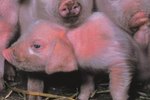A pig's eyes are small, folded and prone to becoming infected or damaged. This is especially true when pigs live in crowded, moist or dirty conditions. Pinkeye, a kind of eye infection, spreads quickly through physical contact and flies, and can lead to blindness. Owners should treat pinkeye quickly to keep it from spreading.
Washing
Wash out a pig's eyes before assuming that they're infected. Most pigs have small, folded eyes surrounded by bristling eyelashes, and are prone to runny eyes to start with. If you notice that a pig's eyes are runnier than usual, or puffy, try cleaning them with a washcloth and warm water. If something is stuck in the pig's eyes and causing a problem, this may clear them out.
Antibiotics
The most widely accepted treatment for pigs with confirmed pinkeye is antibiotic ointment. Vets prescribe a topical ointment that contains penicillin. Spread the ointment along the inside of the eyelid, where the pig's eyeball meets the skin, and allow the ointment to do its work. This treatment is sometimes successful after only one application. When you're treating a pig with pinkeye, make sure to wash your hands before you handle any other pigs. The bacteria that causes pinkeye can be easily transferred to other animals via your skin or clothing.
Vitamin E
Although it is not a medically recognized treatment for eye infections, many pig owners find that increasing a pig's intake of vitamin E leads to better overall eye health. Feed pigs a vitamin E solution by mixing it into their food or water every day, and maintain a consistent level of Vitamin E to prevent future outbreaks of pinkeye. Vitamin E will also lead to healthier pig skin and feet.





